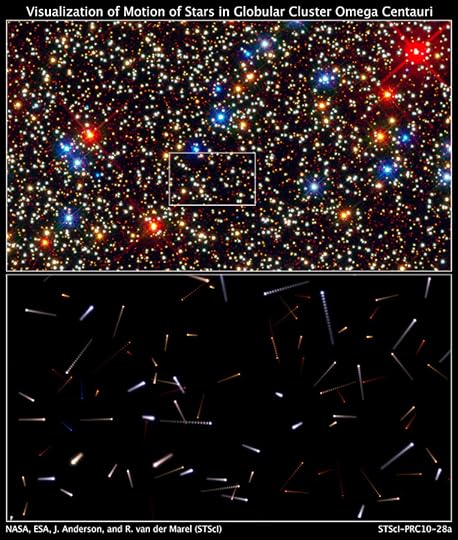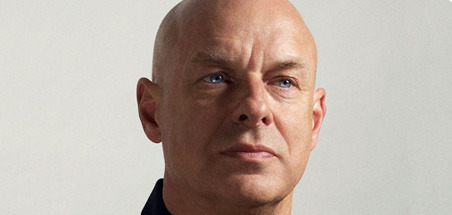Stewart Brand's Blog, page 112
November 4, 2010
Rosetta Disk at the Hammer Museum for an "Enormous Microscopic Evening"
Join Long Now's Rosetta Project on November 6 from 4 – 7 pm at UCLA's Hammer Museum where we team up with San Francisco-based CRITTER for an Enormous Microscopic Evening. We'll put a Rosetta Disk under the microscope, check out the fine (and finer) print, and maybe hunt for Easter eggs… More information on the evening's lineup from the Hammer Museum:
Enormous Microscopic Evening examines the museum from a microscopic perspective with CRITTER, a San Francisco-based salon dedicated to expanding the relationships between culture and the environment. The evening will focus on demonstrations and workshops about building and manipulating microscopes. Materials and samples taken from around the museum will be examined. Continuing the theme of microscopy, there will be micro performances (short concerts with tiny instruments) and other related events throughout the museum.







Sounds of yesterday gone forever
1958, file photo, Duke Ellington
One of the readers of this blog "Sinking777″ commented on an earlier post and pointed out this digital dark age story on a recent study of sound recordings:
The first comprehensive study of the preservation of sound recordings in the U.S., released by the Library of Congress, also found many historical recordings already have been lost or can't be accessed by the public. That includes most of radio's first decade from 1925 to 1935.
Shows by musicians Duke Ellington and Bing Crosby, as well as the earliest sports broadcasts, are already gone. There was little financial incentive for such broadcasters as CBS to save early sound files, Brylawski said.
"Those audio cassettes are just time bombs," Brylawski said. "They're just not going to be playable."
The study also calls for changes in copyright law to help preservation. As it stands now, Brylawski said, copyright restrictions would make most audio preservation initiatives illegal, the authors wrote.
The last bit in the study is very good to see. One of the dirtiest secrets of digital preservation is that it often technically illegal, and this will likely have to change if we are going to have anything approaching a representative record of our increasingly digital civilization.







November 3, 2010
Brian Eno on how to create music of the future
Long Now founding board member Brian Eno has released a new album called Small Craft on a Milk Sea. Recently he gave two great interviews on his creative process, one you can listen to over at NPR, and the other you can read over at Pitchfork. I highly recommend listening and reading to both interviews in the their entirety, but I was especially taken with his answer on how to create music that is truly new:
"Imagine it's the year 2064 and all digital music has been destroyed in a huge digital accident, an electromagnetic pulse or something like that. So, all we know about the music between 2010 or 2030 is hearsay. There don't exist any recordings. We've read about a kind of music that existed in the suburbs of Shanghai in 2015 to 2018, and this music was played on–" then you specify a group of instruments– "was played on, say, industrial tools, such as steel hammers, and augmented with samplers and various electronic versions of some Chinese instruments. And it was intensely repetitive and played at ear-splitting volume," for example. So, we then, taking that brief, try to imagine what that music would be like, and we try to make it.







November 2, 2010
Short news cycle meets long-term thinking
Long Conversation – Pete Worden Announces 100-Year Starship
As part of our Long Conversation event on October 16th, NASA Ames Director Pete Worden discussed a new DARPA/NASA research endeavor he called the "100 Year Starship" (see above). This small mention originally reported by Amara Angelica at the Kurzweil AI blog has sparked a bit of a media dust up with over 70 stories including Nature, Wired, MSNBC and even Fox news trying to turn it into a cover up (bizarre considering he announced it). A few days ago DARPA released an official press release on this project (text of which is below and here is the actual PDF). The release outlines how nascent and speculative this "project" really is.
At Long Now we are obviously happy to see the press taking interest in such a long-term story. It seems to have captured quite a bit of imagination — and speculation. However as you can tell from the press release it is not as though we are going to be hopping on our interstellar space ship tomorrow. Not only will the ride take at least a century, the road to having the technology is likely a century or two out itself. Pete Worden, NASA and DARPA should be praised for taking the first steps to think on this scale. This type of thinking is both rare and brave.
"Throughout history technical challenges have inspired generations to achieve scientific breakthroughs of lasting impact. Several decades ago, for instance, the race to the moon sparked a global excitement surrounding space exploration that persists to this day. The Defense Advanced Research Projects Agency (DARPA) and the NASA Ames Research Center have teamed together to take the first step in the next era of space exploration — a journey between the stars.
"The 100-Year Starship study will examine the business model needed to develop and mature a technology portfolio enabling long-distance manned spaceflight a century from now. This goal will require sustained investments of intellectual and financial capital from a variety of sources. The yearlong study aims to develop a construct that will incentivize and facilitate private co-investment to ensure continuity of the lengthy technological time horizon needed.
"'The 100-Year Starship study is about more than building a spacecraft or any one specific technology,' said Paul Eremenko, DARPA coordinator for the study. 'We endeavor to excite several generations to commit to the research and development of breakthrough technologies and cross-cutting innovations across a myriad of disciplines such as physics, mathematics, biology, economics, and psychological, social, political and cultural sciences, as well as the full range of engineering disciplines to advance the goal of long-distance space travel, but also to benefit mankind.'
"DARPA also anticipates that the advancements achieved by such technologies will have substantial relevance to Department of Defense (DoD) mission areas including propulsion, energy storage, biology/life support, computing, structures, navigation, and others. Beyond the DoD and NASA, these investments will reinvigorate private entrepreneurs, the engineering and scientific community, and the world's youth in a bold quest for the stars.
"The 100-Year Starship study looks to develop the business case for an enduring organization designed to incentivize breakthrough technologies enabling future spaceflight."
[October 28th 02010, DARPA news release. Media with inquiries, contact DARPA Public Affairs, DARPAPublicAffairsOffice@darpa.mil]







10,000 Years of stellar motion

10,000 Years of star motion Credit: NASA, ESA, and G. Bacon (STScI)
There is an interesting bit of astronomy published over at PhysOrg.com sent to me by way of Danny Hillis and Tom Shannon. Apparently astronomers focused Hubble on a certain region of Globular Cluster Omega Cantauri several times over 4 years. They were then able to calculate how each of those stars will move in the next 10,000 years. You can see a video of this after the jump on their site here. It reminds me of our recent blog piece on how the constellations will change over the next 50,000 years. All of this is of interest to us on the Clock project as one of the main references we use is an image of the night sky for one of our slowest moving dials. We have to choose stars that do not move very much over the next 10,000 years to use as a good reference in the 26,000 year precessional cycle.







November 1, 2010
Long Now Media Update

LISTEN
(summary and downloads tabs)
13 – 19 of Nineteen Speakers in the
"Long Conversation"
There is new media available from our monthly series, the Seminars About Long-term Thinking. Stewart Brand's summaries and audio downloads or podcasts of the talks are free to the public; Long Now members can view HD video of the Seminars and comment on them.







October 29, 2010
Opening Celebration: Global Lives Project at the Long Now
Opening: Global Lives Project Installation
at The Long Now Museum & Store
Wednesday November 10
6:00 – 8:00 pm
We'll be celebrating the opening of a Global Lives Project installation at the Long Now Foundation Museum & Store on the evening of November 10th. Please join us for drinks, snacks and some words from Global Lives Project Founder and Executive Director, David Evan Harris. Global Lives Project filmmakers Ya-Hsuan Huang and Jason J. Price will also be in attendance to answer questions.
The Global Lives Project is a collaboratively-built library of human experience gathered from an orphanage in Kazakstan, a corner store in China, a street car in San Francisco and many other locations foreign and familiar. It takes shape online and as a video installation.
Framed by the arc of the day and conveyed through the intimacy of video, we have slowly and faithfully captured 24 continuous hours in the lives of 10 people from around the world. They are screened here in their own right, but also in relation to one another.
There is no narrative other than that which is found in the composition of everyday life, no overt interpretations other than that which you may bring to it.
By extending the long take to a certain extreme and infusing it with the spirit of cinema verité, we invite audiences to confer close attention onto other worlds, and simultaneously reflect upon their own. The force and depth of human difference and similarity are revealed in this process. Gaps which mark cultural divides feel, at once, both wider and narrower. This sense – that we, as humans, are both knowable and unknowable, fundamentally different as well as the same – opens a space for dialogue.







Long Now Media Update

LISTEN
(downloads tab)
7 – 12 of Nineteen Speakers in the
"Long Conversation"
There is new media available from our monthly series, the Seminars About Long-term Thinking. Stewart Brand's summaries and audio downloads or podcasts of the talks are free to the public; Long Now members can view HD video of the Seminars and comment on them.







Long Now Media Update

LISTEN
(downloads tab)
1 – 6 of Nineteen Speakers in the
"Long Conversation"
There is new media available from our monthly series, the Seminars About Long-term Thinking. Stewart Brand's summaries and audio downloads or podcasts of the talks are free to the public; Long Now members can view HD video of the Seminars and comment on them.







Seminars, Long Now Announcements

LISTEN
(downloads tab)
1 – 6 of Nineteen Speakers in the
"Long Conversation"
There is new media available from our monthly series, the Seminars About Long-term Thinking. Stewart Brand's summaries and audio downloads or podcasts of the talks are free to the public; Long Now members can view HD video of the Seminars and comment on them.







Stewart Brand's Blog
- Stewart Brand's profile
- 291 followers






